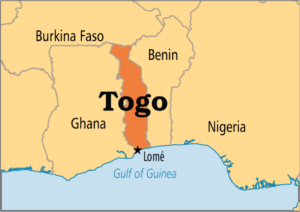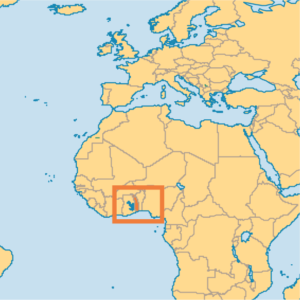TODAY’S READING FROM THE OLD TESTAMENT- EZEKIEL 42:1- 43:27; JAMES 5:1-20; PSALMS 119:1-16; PROVERBS 28:6-7
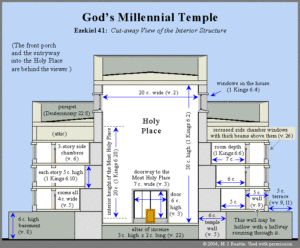 Chapter 42 is dedicated to the description of the Temple Complex buildings surrounding the central sanctuary. They are all contained on the sacred precincts of the temple shown to the prophet in the vision. Ezekiel is given the precise measurements and instructions as to the purpose of the chambers in the buildings. Rooms were dedicated to serve the needs of the priests as sacrifices were prepared and the priests’ portions were eaten.
Chapter 42 is dedicated to the description of the Temple Complex buildings surrounding the central sanctuary. They are all contained on the sacred precincts of the temple shown to the prophet in the vision. Ezekiel is given the precise measurements and instructions as to the purpose of the chambers in the buildings. Rooms were dedicated to serve the needs of the priests as sacrifices were prepared and the priests’ portions were eaten.
Notice, in Ezekiel 42:13-14, there is a distinction between the ‘holy’ (that which is set apart exclusively for ministry unto the Lord) and the ‘profane’ (that which is to be used or worn in service to one’s fellow man). A change of clothes was required to minister to the Lord in worship. A priest needed to change his clothes again before going out to interact with others in service or any social interaction (Ezekiel 42:14).
Ezekiel 42:20 20 He measured it on the four sides; it had a wall all around, the length five hundred and the width five hundred, to divide between the holy and the profane.
The graduated levels and divisions that led to the holy of holies provided a separating line of demarcation between the holy and the common. These chambers were dedicated exclusively for worship and sacrifice to Yahweh.
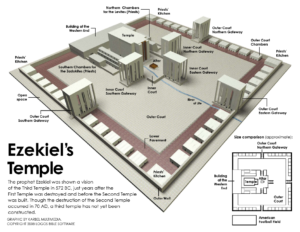 After measuring the inner house and surrounding buildings, Ezekiel is told to take his measuring reed and measure the entire complex, all the land that was allotted for the sanctuary. It measures 500 by 500 reeds. We learn that the measure of the reed is a cubit plus a handbreadth.
After measuring the inner house and surrounding buildings, Ezekiel is told to take his measuring reed and measure the entire complex, all the land that was allotted for the sanctuary. It measures 500 by 500 reeds. We learn that the measure of the reed is a cubit plus a handbreadth.
Ezekiel is shown by the angel, who is acting as his tour guide, that this future temple exceeds all the former temples in size and beauty. He is told to share this vision with the exiles. It may explain why the temple that would later be reconstructed under Zerubbabel was a disappointment to some and caused them to weep. Not only would that temple not compare to the glory of Solomon’s temple in the past, it did not match the glory of Ezekiel’s envisioned temple for the future.
The Apostle Paul reminds us that the events and places described in the Old Testament are relevant to New Testament believers.
1 Corinthians 10:6a 6 Now these things happened as examples for us”
The Greek word translated ‘example’ in 1 Corinthians 10:6 is ‘tupos’ from which we get the English word ‘type. A ‘type’ is an image, or impression, like that which is stamped on the face of a coin. The type is a representation of a real person or object. The Old Testament sacrificial system of worship described in the ceremonial law were prophetic representations, or ‘types’, of the life and work of the Perfect Priest and Perfect sacrifice of Christ.
Here in Ezekiel’s Temple, as in the Tabernacle of Moses in the wilderness and the Temple of Solomon in Israel, the inner sanctuary, the third division in the temple building known as the Holy of Holies, speaks of God’s desire to dwell with His people through the mediation of Christ.
John 1:14 14 And the Word became flesh, and dwelt (tabernacled) among us, and we saw His glory, glory as of the only begotten from the Father, full of grace and truth.
This desire is realized fully in the Book of Revelation:
Revelation 21:3 3 And I heard a loud voice from the throne, saying, “Behold, the tabernacle of God is among men, and He will dwell among them, and they shall be His people, and God Himself will be among them,
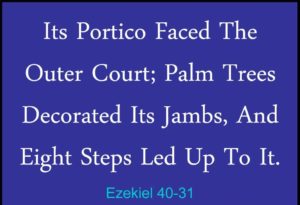 Notice the repetition of the number 8. There were 8 steps leading up to the inner court of the priests in the temple area.
Notice the repetition of the number 8. There were 8 steps leading up to the inner court of the priests in the temple area.
Ezekiel 40:31 31 Its porches were toward the outer court; and palm tree ornaments were on its side pillars, and its stairway had eight steps.
Ezekiel 40:34 34 Its porches were toward the outer court; and palm tree ornaments were on its side pillars, on each side, and its stairway had eight steps.
Ezekiel 40:37 37 Its side pillars were toward the outer court; and palm tree ornaments were on its side pillars on each side, and its stairway had eight steps.
The number 8 is a type of the Messiah establishing the Kingdom in the New Day. The eighth day is the first day of a new week. Jesus finishes the work of redemption and then provides the way into the sanctuary of God’s holiness. He provides a new beginning for humanity, a new creation. Jesus rose on the first day of a new week, the eighth day. There are eight tables for preparing sacrifices. The sacrifices in Ezekiel’s vision were all performed on the eighth day.
Ezekiel 43:27 27 ‘When they have completed the days, it shall be that on the eighth day and onward, the priests shall offer your burnt offerings on the altar, and your peace offerings; and I will accept you,’ declares the Lord GOD.”
There is no court of the Gentiles nor a court of women, for all are one in Christ Jesus. God’s temple is a house of prayer for all nations and all people, male and female.
There is no altar of incense nor a seven-branched golden lampstand in the Holy Place. Because the Lord is present with them, there is no need for symbolic prayer. Because the light of the glory of God is with them, no lampstand is needed.
There is no veil separating the Holy Place and the Holiest of All (the inner sanctuary). Nor is there any reference to the ark of the covenant with the mercyseat that would receive the sprinkled blood on the annual day of Atonement.
Notice there were three levels in the temple structure. The plan of redemption was in the heart and mind of the Triune God. The Father, in love, planned it (Ephesians 1:3-6). The Son, in love, executed it (Ephesians 1:7-12). The Holy Spirit, in love, reveals it and actualizes it in the experience of the believer (Ephesians 1:13-14).
The three levels and side rooms for the priests were only accessible through the middle level, so the only way into fellowship with the Father and the Spirit and the place prepared for the priests is through the middle, the second person of the Godhead Jesus Christ.
Ezekiel 41:7 7 The side chambers surrounding the temple were wider at each successive story. Because the structure surrounding the temple went upward by stages on all sides of the temple, therefore the width of the temple increased as it went higher; and thus, one went up from the lowest story to the highest by way of the second story.
Palm trees are carved in the woodwork and are featured on the walls (Ezek 40:16, 22, 26, 31; 41:18-20, 25-25). They are a national symbol reflecting the hope of peace and long life. Jesus is Israel’s hope, the Prince of Peace. He has made peace through His self-giving sacrifice on the cross in which He shed His blood to atone for our sins. Just as the carved golden cherubim on the lid of the mercyseat in the tabernacle looked to the shed blood sprinkled there as a prerequisite for the visitation of God’s glory, so the cherubim in Ezekiel’s temple look to the palm tree, the promised Son of David, who finished the work of redemption.
Without being necessarily aware of it, when Jesus entered Jerusalem prior to His crucifixion, the people waved palm branches, put them on the ground before Him, shouting “Hosanna (Save us!) Son of David!” (John 12:13; Psalm 92:12) on what we call ‘Palm Sunday’. It was a prophetic picture of the palms of the nation honoring Israel’s hope.
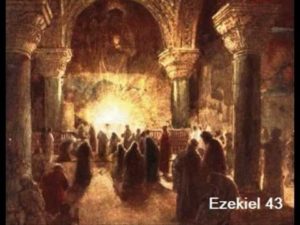 Chapter 43 describes the return of the glory of the Lord to the sanctuary. When the work of constructing the tabernacle was finished in Exodus 40:34-38), and the work of constructing Solomon’s temple was complete and dedicated (1 Kings 8:10-11), the glory of the Lord was manifested and filled the sanctuary. Now Ezekiel has a vision of the glory of the Lord returning to the new temple in Jerusalem by way of the east. Because there is no longer a veil, God’s glory will be manifest to all.
Chapter 43 describes the return of the glory of the Lord to the sanctuary. When the work of constructing the tabernacle was finished in Exodus 40:34-38), and the work of constructing Solomon’s temple was complete and dedicated (1 Kings 8:10-11), the glory of the Lord was manifested and filled the sanctuary. Now Ezekiel has a vision of the glory of the Lord returning to the new temple in Jerusalem by way of the east. Because there is no longer a veil, God’s glory will be manifest to all.
When Ezekiel sees the glory of God returning, He notes that the voice was similar to what he heard in his first vision of the glory of the Lord. It was as the sound of many waters (Ezekiel 1:24). I imagine it similar to the thundering power of Niagara Falls. This is how the Apostle John heard it in the Book of Revelation (Revelation 1:15; 14:2; 19:6).
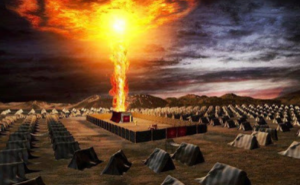 The Apostle John saw the glory of God returning in Christ in His first coming (John 1:14).
The Apostle John saw the glory of God returning in Christ in His first coming (John 1:14).
Ezekiel predicts the glory of the Lord returning to the new temple in the Messianic age. Whether or not there is a literal temple in the millennium, we read of a temple in the Book of Revelation. It is Jesus (Revelation 21:22).
The manifestation of the glory of God as a bright light in the Old Testament has been called the ‘skekinah’ glory, although this term is not used in the Bible. The word ‘shekinah’ comes from the verb, ‘sakan’, which means ‘to rest’ or ‘to abide’. This verb is used in Exodus 24:16.
Exodus 24:16 16 The glory of the LORD rested on Mount Sinai, and the cloud covered it for six days; and on the seventh day He called to Moses from the midst of the cloud.
The shepherds at Bethlehem experienced the glory of God when the angels announced the birth of Christ (Luke 2:8-10).
Once again, Ezekiel falls prostrate at the appearing of God’s glory (43:3; 1:28). The Spirit lifts him up and takes him to the inner court, where the glory of the Lord fills the temple. There Ezekiel hears the good news: The glory of God will rest with His people forever (43:7).
Ezekiel is told to describe the vision that they might be ashamed of their iniquities. They should ‘consider the plan’ (43:10). We need to have people hear of Christ and consider God’s plan of salvation- which is to believe the good news of what He has done in the person of His Son.
TODAY’S READING FROM THE NEW TESTAMENT – JAMES 5:1-20
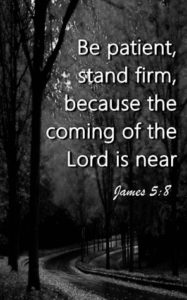 James gives a strong denunciation of those people who have gained their wealth by abusing others. He says that there are those in their midst who are wealthy yet defraud their workers, withholding promised compensation.
James gives a strong denunciation of those people who have gained their wealth by abusing others. He says that there are those in their midst who are wealthy yet defraud their workers, withholding promised compensation.
He exhorts all those who suffer abuse, oppression, and persecution, to be patient, because the day of their vindication draws near with the return of Christ. The Lord of hosts (Sabaoth) sees every injustice, hears every prayer, and will put all right.
These words bring those of C.S. Lewis in the Chronicles of Narnia to mind:
Wrong will be right, when Aslan comes in sight,
At the sound of his roar, sorrows will be no more
When he bares his teeth, winter meets its death
And when he shakes his mane, we shall have spring again.
Patience is the attitude of God Himself. He, like the farmer, is waiting for the precious fruit of the earth. We are called to fellowship with God’s patience as we endure times of suffering.
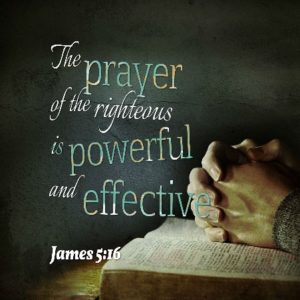 James reminds the believers to be a people of integrity. When you make a commitment, keep it. Your word should be your bond. Be a community that knows how to minister one to another. There should be a ministry of song, prayer for the sick, confession of sin, and earnest prayer for supernatural intervention in the local congregation. God is faithful. He can restore the sick, raise up those who are bedridden, restore broken relationships, interact with and overrule natural laws. The effective prayer of a righteous man AVAILS much! And Jesus is that righteous man! Get right with The Lord our Righteousness, and don’t be shy to pray big prayers in His Name!
James reminds the believers to be a people of integrity. When you make a commitment, keep it. Your word should be your bond. Be a community that knows how to minister one to another. There should be a ministry of song, prayer for the sick, confession of sin, and earnest prayer for supernatural intervention in the local congregation. God is faithful. He can restore the sick, raise up those who are bedridden, restore broken relationships, interact with and overrule natural laws. The effective prayer of a righteous man AVAILS much! And Jesus is that righteous man! Get right with The Lord our Righteousness, and don’t be shy to pray big prayers in His Name!
Let’s be people who care enough to rescue those who are in peril (James 5:19-20).
 James 5:19-20 19 My brethren, if any among you strays from the truth and one turns him back, 20 let him know that he who turns a sinner from the error of his way will save his soul from death and will cover a multitude of sins.
James 5:19-20 19 My brethren, if any among you strays from the truth and one turns him back, 20 let him know that he who turns a sinner from the error of his way will save his soul from death and will cover a multitude of sins.
TODAY’S READING FROM THE BOOK OF PSALMS- PSALMS 119:1-16
Here we are again, in the great Psalm of The Word! Spiritually prosperous and happy are those who know the Word of God! We are not just to hear the Word, read the Word, hide it in our hearts, but we are to walk in the way of the Word.
Psalm 119:1-3 1 How blessed are those whose way is blameless, who walk in the law of the LORD. 2 How blessed are those who observe His testimonies, who seek Him with all their heart. 3 They also do no unrighteousness; They walk in His ways.
May all those who read the Word discover Christ and trust Him as ‘the way’ of the righteous.
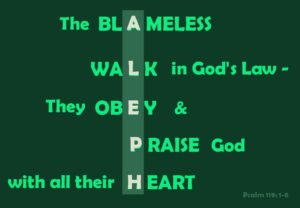 Remember this Psalm is divided into 22 sections, one section of 8 verses for each letter of the Hebrew alphabet, each line beginning with the same letter. Verses 1-8 begin with the Hebrews letter, ‘aleph’; 9-16 with ‘beth’. 8 different words are used for ‘the word’. Notice here in the first verse, ‘the Law’ (Torah- in Hebrew). The other words are: ‘testimony’, ‘precept’, ‘statute’, ‘commandment’, ‘judgment’ (principle of living), ‘word of God’ and ‘promise’.
Remember this Psalm is divided into 22 sections, one section of 8 verses for each letter of the Hebrew alphabet, each line beginning with the same letter. Verses 1-8 begin with the Hebrews letter, ‘aleph’; 9-16 with ‘beth’. 8 different words are used for ‘the word’. Notice here in the first verse, ‘the Law’ (Torah- in Hebrew). The other words are: ‘testimony’, ‘precept’, ‘statute’, ‘commandment’, ‘judgment’ (principle of living), ‘word of God’ and ‘promise’.
TODAY’S READING FROM THE BOOK OF PROVERBS- PROVERBS 28:6-7
Proverbs 28:6-7 6 Better is the poor who walks in his integrity than he who is crooked though he be rich. 7 He who keeps the law is a discerning son, but he who is a companion of gluttons humiliates his father.
The first part of these proverbs, verse 6, sounds like it came from today’s readings in the 5th chapter of James. Verse 7 sounds like an exposition of Psalm 119:1, and the last phrase is a summary of the grief caused when one squanders one’s life in a lifestyle of self-indulgence.
PRAY FOR THE NATIONS -TOGO
Togolese Republic
Africa
Located on the Gulf of Guinea in West Africa, Togo (Ewe word for “lake”) was colonized by both Germany and France before gaining its independence in 1960. Since becoming an independent nation, Togo has struggled to become a unified country. In 2005, following the death of their president, the military appointed his son as the next leader, which led to violent protests and 40,000 people fleeing the country. The nation has one political party (Rally of the Togolese People) and is also a military-civilian regime, which gives civilians control of the military.
Many diseases plague the Togolese people, including HIV/AIDS and Malaria, which is the leading cause of death in the nation. There are also some ethnic tensions between the people in the north and the south. Women are legally considered equal, but culturally they are still inferior and are discriminated against in the workplace and government programs. The society is extremely patrilineal. Agriculture is the largest economic sector and employs 65% of the workforce. The average daily income in Togo is under $1.25.
This French-speaking nation was anti-Christian in the 1970’s but has since become more ambivalent, giving its people religious freedom. Christianity has grown significantly since the 1990’s, and Christ is now claimed by 30% of the population. The rest follow traditional African beliefs (50%) and Islam (20%). Unity within the Church and syncretism have become huge issues for believers as ancestor worship and other African rituals have made their way into Christian services. There is a great need for the younger generation to be reached, with over 300,000 orphaned and unwanted children exploited in the sex trade and child labor. Others are being manipulated with the promise of work and converting to Islam. Pray that the Church will be able to break away from the traditional beliefs, such as ancestor worship, and that the Togolese believers will continue to grow in their faith
Geography
The Atlantic coastline is only 56 km long, but the land stretches 540 km northward to the Sahel; wedged between Ghana and Benin.
Population: 6,780,030 Annual Growth: 2.50%
Capital: Lomé
Urbanites: 43.4%
HDI Rank: 159 of 182 (UN Human Development Reports 2009)
Peoples
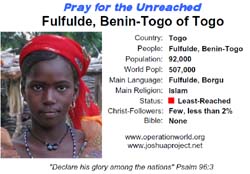 Peoples: 56 (11% unreached) All peoples
Peoples: 56 (11% unreached) All peoples
Unreached Peoples Prayer Card
Official language: French. Only two indigenous languages used in education system: Ewe/Mina and Kabiye Languages: 43 All languages
Religion
Largest Religion: Christian
| Religion | Pop % | Ann Gr | |
| Christians | 3,076,778 | 45.38 | 3.0 |
| Evangelicals | 722,952 | 10.7 | 4.7 |
Challenges for Prayer
Bible translation remains a major ministry challenge. The whole Bible is completed in Kabiye, one of two indigenous languages used in schools. Four languages have definite Bible translation needs. Work in 12 languages is in progress, much of it by WBT workers. Training national translation workers is now one of the greatest priorities for Bible translation.
Christian media ministries for prayer are:
a) Christian literature is in great demand and cheap to produce. Pray for the ministry of The Bible Society as well as the CLC and ABWE bookshops in distributing Scripture. ABWE, WBT and others undertake literacy projects, which enable such resources to be used.
b) Audio resources are vital in this low-literacy nation. GRN produced materials in 55 languages, including the FCBH series. Audio Scripture Ministries trains nationals to produce Christian audio resources such as music and teaching.
c) EHC distributes hundreds of thousands of pieces of literature as well as ministers through primary health care to the communities they reach.
d) Christian radio and TV. Local stations broadcast Christian programs; there is also one well-acclaimed Christian radio station in Lomé. Christian television channels include Television la Solution and TV Zion. African Christian Television produces programs for broadcast on the national channels. The JESUS film is shown extensively in film and on TV and is available in 18 languages.
PRAYER: Lord, we love Your Law. We delight in Your testimonies. We rejoice in Your statutes. We thank You for Your Word made flesh in the person of Your Son. We are grateful that He tabernacled among us and fulfilled every ordinance required to put us in a right relationship to You. We embrace His merits on our behalf and come boldly before You. May Your thundering voice and Your Spirit’s power govern our walk and make us fruitful in every good work. In Jesus’ Name. Amen.
Pastor David

